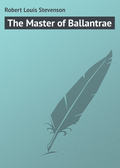
Роберт Льюис Стивенсон
Records of a Family of Engineers
The upper course of the lighthouse at the workyard of Arbroath was completed on the 6th, and the whole of the stones were, therefore, now ready for being shipped to the rock. From the present state of the works it was impossible that the two squads of artificers at Arbroath and the Bell Rock could meet together at this period; and as in public works of this kind, which had continued for a series of years, it is not customary to allow the men to separate without what is termed a “finishing-pint,” five guineas were for this purpose placed at the disposal of Mr. David Logan, clerk of works. With this sum the stone-cutters at Arbroath had a merry meeting in their barrack, collected their sweethearts and friends, and concluded their labours with a dance. It was remarked, however, that their happiness on this occasion was not without alloy. The consideration of parting and leaving a steady and regular employment, to go in quest of work and mix with other society, after having been harmoniously lodged for years together in one large “guildhall or barrack,” was rather painful.
[Friday, 6th July]
While the writer was at Edinburgh he was fortunate enough to meet with Mrs. Dickson, only daughter of the late celebrated Mr. Smeaton, whose works at the Eddystone Lighthouse had been of such essential consequence to the operations at the Bell Rock. Even her own elegant accomplishments are identified with her father’s work, she having herself made the drawing of the vignette on the title-page of the Narrative of the Eddystone Lighthouse. Every admirer of the works of that singularly eminent man must also feel an obligation to her for the very comprehensive and distinct account given of his life, which is attached to his reports, published, in three volumes quarto, by the Society of Civil Engineers. Mrs. Dickson, being at this time returning from a tour to the Hebrides and Western Highlands of Scotland, had heard of the Bell Rock works, and from their similarity to those of the Eddystone was strongly impressed with a desire of visiting the spot. But on inquiring for the writer at Edinburgh, and finding from him that the upper part of the lighthouse, consisting of nine courses, might be seen in the immediate vicinity, and also that one of the vessels which, in compliment to her father’s memory, had been named the Smeaton, might also now be seen in Leith, she considered herself extremely fortunate; and having first visited the works at Greenside, she afterwards went to Leith to see the Smeaton, then loading for the Bell Rock. On stepping on board, Mrs. Dickson seemed to be quite overcome with so many concurrent circumstances, tending in a peculiar manner to revive and enliven the memory of her departed father, and, on leaving the vessel, she would not be restrained from presenting the crew with a piece of money. The Smeaton had been named spontaneously, from a sense of the obligation which a public work of the description of the Bell Rock owed to the labours and abilities of Mr. Smeaton. The writer certainly never could have anticipated the satisfaction which he this day felt in witnessing the pleasure it afforded to the only representative of this great man’s family.
[Friday, 20th July]
The gale from the N.E. still continued so strong, accompanied with a heavy sea, that the Patriot could not approach her moorings; and although the tender still kept her station, no landing was made to-day at the rock. At high-water it was remarked that the spray rose to the height of about sixty feet upon the building. The Smeaton now lay in Leith loaded, but, the wind and weather being so unfavourable for her getting down the Firth, she did not sail till this afternoon. It may be here proper to notice that the loading of the centre of the light-room floor, or last principal stone of the building, did not fail, when put on board, to excite an interest among those connected with the work. When the stone was laid upon the cart to be conveyed to Leith, the seamen fixed an ensign-staff and flag into the circular hole in the centre of the stone, and decorated their own hats, and that of James Craw, the Bell Rock carter, with ribbons; even his faithful and trusty horse Brassey was ornamented with bows and streamers of various colours. The masons also provided themselves with new aprons, and in this manner the cart was attended in its progress to the ship. When the cart came opposite the Trinity House of Leith, the officer of that corporation made his appearance dressed in his uniform, with his staff of office; and when it reached the harbour, the shipping in the different tiers where the Smeaton lay hoisted their colours, manifesting by these trifling ceremonies the interest with which the progress of this work was regarded by the public, as ultimately tending to afford safety and protection to the mariner. The wind had fortunately shifted to the S.W., and about five o’clock this afternoon the Smeaton reached the Bell Rock.
[Friday, 27th July]
The artificers had finished the laying of the balcony course, excepting the centre-stone of the light-room floor, which, like the centres of the other floors, could not be laid in its place till after the removal of the foot and shaft of the balance-crane. During the dinner-hour, when the men were off work the writer generally took some exercise by walking round the walls when the rock was under water; but to-day his boundary was greatly enlarged, for, instead of the narrow wall as a path, he felt no small degree of pleasure in walking round the balcony and passing out and in at the space allotted for the light-room door. In the labours of this day both the artificers and seamen felt their work to be extremely easy compared with what it had been for some days past.
[Sunday, 29th July]
Captain Wilson and his crew had made preparations for landing the last stone, and, as may well be supposed, this was a day of great interest at the Bell Rock. ‘That it might lose none of its honours,’ as he expressed himself, the Hedderwick praam-boat, with which the first stone of the building had been landed, was appointed also to carry the last. At seven o’clock this evening the seamen hoisted three flags upon the Hedderwick, when the colours of the Dickie praam-boat, tender, Smeaton, floating light, beacon-house, and lighthouse were also displayed; and, the weather being remarkably fine, the whole presented a very gay appearance, and, in connection with the associations excited, the effect was very pleasing. The praam which carried the stone was towed by the seamen in gallant style to the rock, and, on its arrival, cheers were given as a finale to the landing department.
[Monday, 30th July]
The ninetieth or last course of the building having been laid to-day, which brought the masonry to the height of one hundred and two feet six inches, the lintel of the light-room door, being the finishing-stone of the exterior walls, was laid with due formality by the writer, who, at the same time, pronounced the following benediction: “May the Great Architect of the Universe, under whose blessing this perilous work has prospered, preserve it as a guide to the mariner.”
[Friday, 3rd Aug.]
At three p.m., the necessary preparations having been made, the artificers commenced the completing of the floors of the several apartments, and at seven o’clock the centre-stone of the light-room floor was laid, which may be held as finishing the masonry of this important national edifice. After going through the usual ceremonies observed by the brotherhood on occasions of this kind, the writer, addressing himself to the artificers and seamen who were present, briefly alluded to the utility of the undertaking as a monument of the wealth of British commerce, erected through the spirited measures of the Commissioners of the Northern Lighthouses by means of the able assistance of those who now surrounded him. He then took an opportunity of stating that toward those connected with this arduous work he would ever retain the most heartfelt regard in all their interests.
[Saturday, 4th Aug.]
When the bell was rung as usual on the beacon this morning, every one seemed as if he were at a loss what to make of himself. At this period the artificers at the rock consisted of eighteen masons, two joiners, one millwright, one smith, and one mortar-maker, besides Messrs. Peter Logan and Francis Watt, foremen, counting in all twenty-five; and matters were arranged for proceeding to Arbroath this afternoon with all hands. The Sir Joseph Banks tender had by this time been afloat, with little intermission, for six months, during greater part of which the artificers had been almost constantly off at the rock, and were now much in want of necessaries of almost every description. Not a few had lost different articles of clothing, which had dropped into the sea from the beacon and building. Some wanted jackets; others, from want of hats, wore nightcaps; each was, in fact, more or less curtailed in his wardrobe, and it must be confessed that at best the party were but in a very tattered condition. This morning was occupied in removing the artificers and their bedding on board of the tender; and although their personal luggage was easily shifted, the boats had, nevertheless, many articles to remove from the beacon-house, and were consequently employed in this service till eleven a.m. All hands being collected and just ready to embark, as the water had nearly overflowed the rock, the writer, in taking leave, after alluding to the harmony which had ever marked the conduct of those employed on the Bell Rock, took occasion to compliment the great zeal, attention, and abilities of Mr. Peter Logan and Mr. Francis Watt, foremen; Captain James Wilson, landing-master; and Captain David Taylor, commander of the tender, who, in their several departments, had so faithfully discharged the duties assigned to them, often under circumstances the most difficult and trying. The health of these gentlemen was drunk with much warmth of feeling by the artificers and seamen, who severally expressed the satisfaction they had experienced in acting under them; after which the whole party left the rock.
In sailing past the floating light mutual compliments were made by a display of flags between that vessel and the tender; and at five p.m. the latter vessel entered the harbour of Arbroath, where the party were heartily welcomed by a numerous company of spectators, who had collected to see the artificers arrive after so long an absence from the port. In the evening the writer invited the foremen and captains of the service, together with Mr. David Logan, clerk of works at Arbroath, and Mr. Lachlan Kennedy, engineer’s clerk and book-keeper, and some of their friends, to the principal inn, where the evening was spent very happily; and after ‘His Majesty’s Health’ and ‘The Commissioners of the Northern Lighthouses’ had been given, ‘Stability to the Bell Rock Lighthouse’ was hailed as a standing toast in the Lighthouse service.
[Sunday, 5th Aug.]
The author has formerly noticed the uniformly decent and orderly deportment of the artificers who were employed at the Bell Rock Lighthouse, and to-day, it is believed, they very generally attended church, no doubt with grateful hearts for the narrow escapes from personal danger which all of them had more or less experienced during their residence at the rock.
[Tuesday, 14th Aug.]
The Smeaton sailed to-day at one p.m., having on board sixteen artificers, with Mr. Peter Logan, together with a supply of provisions and necessaries, who left the harbour pleased and happy to find themselves once more afloat in the Bell Rock service. At seven o’clock the tender was made fast to her moorings, when the artificers landed on the rock and took possession of their old quarters in the beacon-house, with feelings very different from those of 1807, when the works commenced.
The barometer for some days past had been falling from 29.90, and to-day it was 29.50, with the wind at N.E., which, in the course of this day, increased to a strong gale accompanied with a sea which broke with great violence upon the rock. At twelve noon the tender rode very heavily at her moorings, when her chain broke at about ten fathoms from the ships bows. The kedge-anchor was immediately let go, to hold her till the floating buoy and broken chain should be got on board. But while this was in operation the hawser of the kedge was chafed through on the rocky bottom and parted, when the vessel was again adrift. Most fortunately, however, she cast off with her head from the rock, and narrowly cleared it, when she sailed up the Firth of Forth to wait the return of better weather. The artificers were thus left upon the rock with so heavy a sea running that it was ascertained to have risen to a height of eighty feet on the building. Under such perilous circumstances it would be difficult to describe the feelings of those who, at this time, were cooped up in the beacon in so forlorn a situation, with the sea not only raging under them, but occasionally falling from a great height upon the roof of their temporary lodging, without even the attending vessel in view to afford the least gleam of hope in the event of any accident. It is true that they now had the masonry of the lighthouse to resort to, which, no doubt, lessened the actual danger of their situation; but the building was still without a roof, and the deadlights, or storm-shutters, not being yet fitted, the windows of the lower story were stove in and broken, and at high-water the sea ran in considerable quantities out at the entrance door.
[Thursday, 16th Aug.]
The gale continues with unabated violence to-day, and the sprays rise to a still greater height, having been carried over the masonry of the building, or about ninety feet above the level of the sea. At four o’clock this morning it was breaking into the cook’s berth, when he rang the alarm-bell, and all hands turned out to attend to their personal safety. The floor of the smith’s, or mortar gallery, was now completely burst up by the force of the sea, when the whole of the deals and the remaining articles upon the floor were swept away, such as the cast-iron mortar-tubs, the iron hearth of the forge, the smith’s bellows, and even his anvil were thrown down upon the rock. Before the tide rose to its full height to-day some of the artificers passed along the bridge into the lighthouse, to observe the effects of the sea upon it, and they reported that they had felt a slight tremulous motion in the building when great seas struck it in a certain direction, about high-water mark. On this occasion the sprays were again observed to wet the balcony, and even to come over the parapet wall into the interior of the light-room.
[Thursday, 23rd Aug.]
The wind being at W.S.W., and the weather more moderate, both the tender and the Smeaton got to their moorings on the 23rd, when all hands were employed in transporting the sash-frames from on board of the Smeaton to the rock. In the act of setting up one of these frames upon the bridge, it was unguardedly suffered to lose its balance, and in saving it from damage Captain Wilson met with a severe bruise in the groin, on the seat of a gun-shot wound received in the early part of his life. This accident laid him aside for several days.
[Monday, 27th Aug.]
The sash-frames of the light-room, eight in number, and weighing each 254 pounds, having been got safely up to the top of the building, were ranged on the balcony in the order in which they were numbered for their places on the top of the parapet-wall; and the balance-crane, that useful machine having now lifted all the heavier articles, was unscrewed and lowered, to use the landing-master’s phrase, ‘in mournful silence.’
[Sunday, 2nd Sept.]
The steps of the stair being landed, and all the weightier articles of the light-room got up to the balcony, the wooden bridge was now to be removed, as it had a very powerful effect upon the beacon when a heavy sea struck it, and could not possibly have withstood the storms of a winter. Everything having been cleared from the bridge, and nothing left but the two principal beams with their horizontal braces, James Glen, at high-water, proceeded with a saw to cut through the beams at the end next the beacon, which likewise disengaged their opposite extremity, inserted a few inches into the building. The frame was then gently lowered into the water, and floated off to the Smeaton to be towed to Arbroath, to be applied as part of the materials in the erection of the lightkeepers’ houses. After the removal of the bridge, the aspect of things at the rock was much altered. The beacon-house and building had both a naked look to those accustomed to their former appearance; a curious optical deception was also remarked, by which the lighthouse seemed to incline from the perpendicular towards the beacon. The horizontal rope-ladder before noticed was again stretched to preserve the communication, and the artificers were once more obliged to practise the awkward and straddling manner of their passage between them during 1809.
At twelve noon the bell rung for prayers, after which the artificers went to dinner, when the writer passed along the rope-ladder to the lighthouse, and went through the several apartments, which were now cleared of lumber. In the afternoon all hands were summoned to the interior of the house, when he had the satisfaction of laying the upper step of the stair, or last stone of the building. This ceremony concluded with three cheers, the sound of which had a very loud and strange effect within the walls of the lighthouse. At six o’clock Mr. Peter Logan and eleven of the artificers embarked with the writer for Arbroath, leaving Mr. James Glen with the special charge of the beacon and railways, Mr. Robert Selkirk with the building, with a few artificers to fit the temporary windows to render the house habitable.
[Sunday, 14th Oct.]
On returning from his voyage to the Northern Lighthouses, the writer landed at the Bell Rock on Sunday, the 14th of October, and had the pleasure to find, from the very favourable state of the weather, that the artificers had been enabled to make great progress with the fitting-up of the light-room.
[Friday, 19th Oct.]
The light-room work had proceeded, as usual, to-day under the direction of Mr. Dove, assisted in the plumber-work by Mr. John Gibson, and in the brazier-work by Mr. Joseph Fraser; while Mr. James Slight, with the joiners, were fitting up the storm-shuttters of the windows. In these several departments the artificers were at work till seven o’clock p.m., and it being then dark, Mr. Dove gave orders to drop work in the light-room; and all hands proceeded from thence to the beacon-house, when Charles Henderson, smith, and Henry Dickson, brazier, left the work together. Being both young men, who had been for several weeks upon the rock, they had become familiar, and even playful, on the most difficult parts about the beacon and building. This evening they were trying to outrun each other in descending from the light-room, when Henderson led the way; but they were in conversation with each other till they came to the rope-ladder distended between the entrance-door of the lighthouse and the beacon. Dickson, on reaching the cook-room, was surprised at not seeing his companion, and inquired hastily for Henderson. Upon which the cook replied, ‘Was he before you upon the rope-ladder?’ Dickson answered, ‘Yes; and I thought I heard something fall.’ Upon this the alarm was given, and links were immediately lighted, with which the artificers descended on the legs of the beacon, as near the surface of the water as possible, it being then about full tide, and the sea breaking to a considerable height upon the building, with the wind at S.S.E. But, after watching till low-water, and searching in every direction upon the rock, it appeared that poor Henderson must have unfortunately fallen through the rope-ladder, and been washed into the deep water.
The deceased had passed along this rope-ladder many hundred times, both by day and night, and the operations in which he was employed being nearly finished, he was about to leave the rock when this melancholy catastrophe took place. The unfortunate loss of Henderson cast a deep gloom upon the minds of all who were at the rock, and it required some management on the part of those who had charge to induce the people to remain patiently at their work; as the weather now became more boisterous, and the nights long, they found their habitation extremely cheerless, while the winds were howling about their ears, and the waves lashing with fury against the beams of their insulated habitation.
[Tuesday, 23rd Oct.]
The wind had shifted in the night to N.W., and blew a fresh gale, while the sea broke with violence upon the rock. It was found impossible to land, but the writer, from the boat, hailed Mr. Dove, and directed the ball to be immediately fixed. The necessary preparations were accordingly made, while the vessel made short tacks on the southern side of the rock, in comparatively smooth water. At noon Mr. Dove, assisted by Mr. James Slight, Mr. Robert Selkirk, Mr. James Glen, and Mr. John Gibson, plumber, with considerable difficulty, from the boisterous state of the weather, got the gilded ball screwed on, measuring two feet in diameter, and forming the principal ventilator at the upper extremity of the cupola of the light-room. At Mr. Hamilton’s desire, a salute of seven guns was fired on this occasion, and, all hands being called to the quarter-deck, ‘Stability to the Bell Rock Lighthouse’ was not forgotten.
[Tuesday, 30th Oct.]
On reaching the rock it was found that a very heavy sea still ran upon it; but the writer having been disappointed on two former occasions, and, as the erection of the house might now be considered complete, there being nothing wanted externally, excepting some of the storm-shutters for the defence of the windows, he was the more anxious at this time to inspect it. Two well-manned boats were therefore ordered to be in attendance; and, after some difficulty, the wind being at N.N.E., they got safely into the western creek, though not without encountering plentiful sprays. It would have been impossible to have attempted a landing to-day, under any other circumstances than with boats perfectly adapted to the purpose, and with seamen who knew every ledge of the rock, and even the length of the sea-weeds at each particular spot, so as to dip their oars into the water accordingly, and thereby prevent them from getting entangled. But what was of no less consequence to the safety of the party, Captain Wilson, who always steered the boat, had a perfect knowledge of the set of the different waves, while the crew never shifted their eyes from observing his motions, and the strictest silence was preserved by every individual except himself.
On entering the house, the writer had the pleasure to find it in a somewhat habitable condition, the lower apartments being closed in with temporary windows, and fitted with proper storm-shutters. The lowest apartment at the head of the staircase was occupied with water, fuel, and provisions, put up in a temporary way until the house could be furnished with proper utensils. The second, or light-room store, was at present much encumbered with various tools and apparatus for the use of the workmen. The kitchen immediately over this had, as yet, been supplied only with a common ship’s caboose and plate-iron funnel, while the necessary cooking utensils had been taken from the beacon. The bedroom was for the present used as the joiners’ workshop, and the strangers’ room, immediately under the light-room, was occupied by the artificers, the beds being ranged in tiers, as was done in the barrack of the beacon. The light-room, though unprovided with its machinery, being now covered over with the cupola, glazed and painted, had a very complete and cleanly appearance. The balcony was only as yet fitted with a temporary rail, consisting of a few iron stanchions, connected with ropes; and in this state it was necessary to leave it during the winter.
Having gone over the whole of the low-water works on the rock, the beacon, and lighthouse, and being satisfied that only the most untoward accident in the landing of the machinery could prevent the exhibition of the light in the course of the winter, Mr. John Reid, formerly of the floating light, was now put in charge of the lighthouse as principal keeper; Mr. James Slight had charge of the operations of the artificers, while Mr. James Dove and the smiths, having finished the frame of the light-room, left the rock for the present. With these arrangements the writer bade adieu to the works for the season. At eleven a.m. the tide was far advanced; and there being now little or no shelter for the boats at the rock, they had to be pulled through the breach of sea, which came on board in great quantities, and it was with extreme difficulty that they could be kept in the proper direction of the landing-creek. On this occasion he may be permitted to look back with gratitude on the many escapes made in the course of this arduous undertaking, now brought so near to a successful conclusion.
[Monday, 5th Nov.]
On Monday, the 5th, the yacht again visited the rock, when Mr. Slight and the artificers returned with her to the workyard, where a number of things were still to prepare connected with the temporary fitting up of the accommodation for the lightkeepers. Mr. John Reid and Peter Fortune were now the only inmates of the house. This was the smallest number of persons hitherto left in the lighthouse. As four lightkeepers were to be the complement, it was intended that three should always be at the rock. Its present inmates, however, could hardly have been better selected for such a situation; Mr. Reid being a person possessed of the strictest notions of duty and habits of regularity from long service on board of a man-of-war, while Mr. Fortune had one of the most happy and contented dispositions imaginable.
[Tuesday, 13th Nov.]
From Saturday the 10th till Tuesday the 13th, the wind had been from N.E. blowing a heavy gale; but to-day, the weather having greatly moderated, Captain Taylor, who now commanded the Smeaton, sailed at two o’clock a.m. for the Bell Rock. At five the floating light was hailed and found to be all well. Being a fine moonlight morning, the seamen were changed from the one ship to the other. At eight, the Smeaton being off the rock, the boats were manned, and taking a supply of water, fuel, and other necessaries, landed at the western side, when Mr. Reid and Mr. Fortune were found in good health and spirits.
Mr. Reid stated that during the late gales, particularly on Friday, the 30th, the wind veering from S.E. to N.E., both he and Mr. Fortune sensibly felt the house tremble when particular seas struck, about the time of high-water; the former observing that it was a tremor of that sort which rather tended to convince him that everything about the building was sound, and reminded him of the effect produced when a good log of timber is struck sharply with a mallet; but, with every confidence in the stability of the building, he nevertheless confessed that, in so forlorn a situation, they were not insensible to those emotions which, he emphatically observed, ‘made a man look back upon his former life.’
[1881 Friday, 1st Feb.]
The day, long wished for, on which the mariner was to see a light exhibited on the Bell Rock at length arrived. Captain Wilson, as usual, hoisted the float’s lanterns to the topmast on the evening of the 1st of February; but the moment that the light appeared on the rock, the crew, giving three cheers, lowered them, and finally extinguished the lights.







